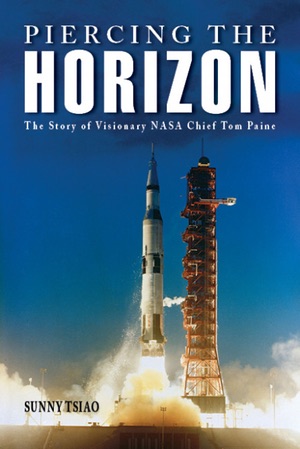Review: Piercing the Horizonby Jeff Foust
|
| Although lacking any experience in space, Tsiao writes that Paine was the “nonpolitical, noncontroversial type of technical manager” NASA was looking for in the aftermath of the Apollo 1 fire. |
That’s a far cry from an earlier NASA administrator, Thomas Paine. It took less than a month from the time President Nixon announced his nomination in March 1969—he had already been serving as acting administrator for several months—to the time he was sworn as the agency’s third administrator. While he held the position for only a year and a half, it came at a critical time in the agency’s history, as described by Sunny Tsiao in his biography of Paine, Piercing the Horizon.
Paine’s career made him, in some respects, an unlikely choice to lead the agency. The son of a naval officer, he joined the Navy in World War II and served on submarines in the Pacific theater. He left the Navy after the war and, after completing graduate work in materials science at Stanford, joined General Electric. He remained there for nearly 20 years, including leading its TEMPO think tank, but never worked on space projects while at the company.
Yet, Paine was approached in late 1967 to become deputy administrator at NASA, a position that opened up when Robert Seamans stepped down. Although lacking any experience in space, Tsiao writes that Paine was the “nonpolitical, noncontroversial type of technical manager” NASA was looking for in the aftermath of the Apollo 1 fire. Paine met James Webb, the administrator of NASA, and found they got along well with each other. Paine was formally nominated by President Johnson in early 1968 and confirmed by the Senate within days.
Within months, Paine became acting administrator. Webb, the book recounts, met with Johnson in mid-September 1968 to discuss transition planning for the final months of Johnson’s administration. Paine believes Webb and Johnson “probably got somewhat swept away” during that discussion and, as a result, the White House announced that Webb would resign in early October. Paine thus became acting administrator just as NASA was preparing for the critical series of Apollo missions leading to the Moon landing.
Paine continued as acting administrator after Nixon took office. Nixon’s staff considered a number of possibilities for administrator, including TRW co-founder Simon Ramo and retired Air Force Gen. Bernard Schriever, but they and others turned it down. Others, meanwhile, advised the new administration to keep Paine, with Seamans telling Defense Secretary Melvin Laird that Paine was the best choice if the administration wanted to keep the Moon landing on schedule. Paine thus got the job on a full-time basis.
Paine oversaw NASA during that series of Apollo missions, culminating with the successful landing on Apollo 11. At the same time, though, he was seeking to determine the future of the agency as Apollo wound down. Budget cuts had already led to the cancellation of later Apollo missions and delayed Skylab. Paine offered his own view of the future of space to the new administration: a space station, a settlement on the Moon, and, eventually, human missions to Mars.
Nixon, though, didn’t support such an ambitious plan. Instead, he supported a proposal to develop what would become the Space Shuttle, followed at some future point by a station; humans to Mars would be deferred to at least the end of the 20th century. Paine, the book states, was not a fan of the shuttle, and as late as 1990 advised Vice President Dan Quayle to end the program as soon as possible.
| Paine again pushed for human missions to Mars on the Augustine Committee. That irritated some other members, more interested in science missions, to the point where Paine was dubbed the “Chief Martian Monster.” |
Paine, disappointed with that lack of support for a long-term space exploration vision and concluding that running the agency had become “less rewarding” in an era of budget austerity, decided to resign, a move that still surprised many. Within weeks after leaving NASA, he was back at GE as an executive there, and would later become head of Northrop before going into consulting.
The book makes clear Paine’s interest in long-term planning. That’s most evident in his role as chairman of the President’s Commission on Space in the mid-1980s, which developed a comprehensive 50-year plan for space exploration, focused on human settlement of the Moon and Mars. But he also worked on long-term planning when he returned to GE in the 1970s, finding company executives had little appetite for such efforts. Paine served on an advisory committee in 1990 led by Norm Augustine (known as the Augustine Committee, not to be confused with another committee led by Augustine in 2009) where he again pushed for human missions to Mars. That irritated some other members, more interested in science missions, to the point where Paine was dubbed the “Chief Martian Monster.” Mars became a long-term goal of that committee, but one “relieved of schedule pressures.”
Piercing the Horizon offers a detailed history of Paine, someone often overlooked in the history of the space agency despite being in charge of it at one of its key moments. At a little more than 200 pages, excluding references and other end matter, the book moves swiftly though much of his life, including parts of his time at NASA. It is, though, a fine examination of the life of a man who had far-reaching visions of the future of humans in space—plans that, decades later, remain only that.
